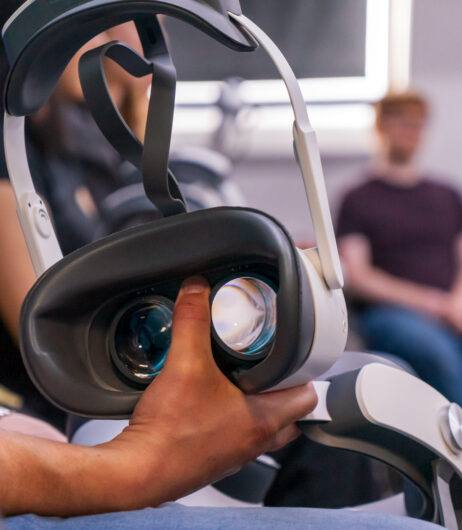Home Knowledge Base If my gadget-loving dad isn’t sold on smart glasses, what will it take to win people over?
If my gadget-loving dad isn’t sold on smart glasses, what will it take to win people over?
8th October 2025

Written by
Share
Categories
My dad is the definition of an early adopter. He has multiple robots roaming the house – a hoover that cleans at the push of a button and a lawnmower that dutifully trims the grass without complaint. He owned one of the very first GPS units, back when it could only tell you your current location and nothing else (which seems pointless now in 2025), and he’s always been at the forefront of tech. If it’s shiny, smart, or controlled via an app, chances are he’s bought it, tested it, and told me about it.
So, when I asked him what he thought about smart glasses and why they haven’t reached the mainstream yet, I expected him to get all excited about the latest Meta smart glasses and tell me I was wrong.
Instead, he just shrugged and said: “It’s simple: privacy.”
He went on to explain that while people are often happy to overshare their own content online, they become much more uncomfortable at the thought of being recorded, analysed or augmented by someone else’s device. A pair of glasses with a built-in camera and AI backend might be able to do clever things – from real-time transcription to object recognition – but for the person being observed, it feels invasive.
As he put it, people embrace wearables that focus on health or audio i.e., smart watches and headphones that can now do so much more than tell the time and play music, but the video element, and the fact that the glasses sit on someone’s face, feels somehow more intrusive.

Why UK adults aren’t sold on smart glasses
But my dad isn’t alone in this. According to YouGov, 49% of surveyed adults were ‘Not at all interested’ in smart glasses, and only 6% were ‘very interested’. Trawling the internet, here’s the most common reasons I found for people’s hesitancy in adopting them:
- Privacy concerns – Glasses with cameras make people wary, no matter how many LED indicators or on/off toggles you add. Trust takes time, especially when the product is coming from the likes of Meta.
- Price point – At £700–£800, smart glasses cost as much as a flagship smartphone, but with far fewer functions. That makes the purchase hard to justify.
- Form factor and comfort – Battery life, chunky frames and prescription-lens headaches all make them less appealing for everyday use. Even with the Ray-Ban Meta line, warranties only hold if lenses are fitted through official channels – which isn’t cheap.
- Utility vs gimmick – For many, the features feel nice-to-have but not essential. When an AI assistant glitches live on stage at Meta Connect, it doesn’t exactly boost confidence.
These obstacles are natural for early-stage technology. After all, the first mobile phones were heavy, expensive and useful only for calls. Plenty of people thought they’d never take off.
Why the tech giants aren’t worried
If it feels like been here before, it’s because we have. Google Glass in 2013 promised a new way of interacting with information, but quickly ran into social, technical, and price barriers. It was mocked, even banned in some public places, and ultimately retreated from the consumer market.
But Google Glass also proved the concept – and, crucially, helped fund the research that drives today’s smarter, sleeker iterations. For big players like Meta, Apple and Google, smart glasses are a long game. Billions are being invested because the potential is enormous:
- Ecosystem growth – Everyday apps and services that make smart glasses truly indispensable.
- Hardware evolution – Lighter frames, better lenses, and longer-lasting batteries.
- Social acceptance – Designs that feel natural and norms that make wearing them as ordinary as pulling out a phone.
The trajectory mirrors smartphones almost exactly. What began as clunky bricks turned into the slim, powerful devices we can’t live without.

The takeaway
My dad said it best: adoption depends on a genuine need. A wearable that restores or expands a human ability will be welcomed. A device that feels like constant surveillance won’t.
And that contrast between curiosity and caution is exactly why mainstream adoption hasn’t happened yet. The technology is impressive, but the trust – and the killer everyday use case – isn’t there.
For now, if my robot-owning, gadget-loving dad doesn’t want smart glasses, maybe the mainstream isn’t ready either. But history suggests patience will pay off. Just like mobile phones, smart glasses may one day shift from niche novelty to everyday essential.
Why early adopters matter – and why brands shouldn’t wait
For brands and agencies, this hesitation isn’t a reason to hold back – it’s a signal that the field is wide open. The companies that start experimenting now, whether that’s by developing truly useful applications or by creating engaging advertising formats designed for smart glasses, will be the pioneers who define the space.
Every technology goes through this phase – uncertain, slightly awkward, and seemingly niche – before the “killer apps” arrive that make it indispensable. By investing early, brands not only get a head start in understanding what works, but they also help shape the consumer experiences that will eventually drive mainstream adoption.
At Infinite Form, we see smart glasses not as a question of if, but when. And for the brands that want to be remembered as innovators rather than late adopters, now is the moment to start exploring what’s possible.
Related posts

How creative agencies can use immersive tech to drive results

by Infinite Form
13th Sep 2024

How creative agencies can use immersive tech to drive results

by Infinite Form
13th Sep 2024














